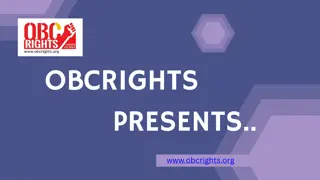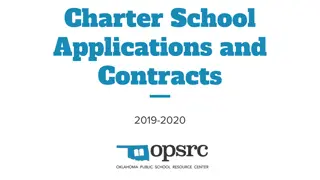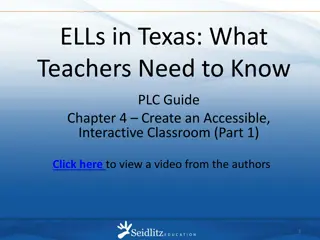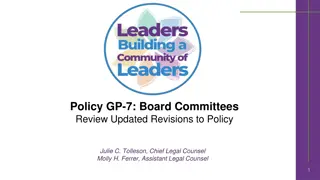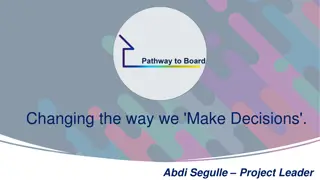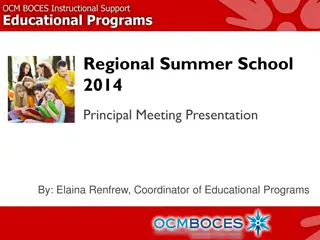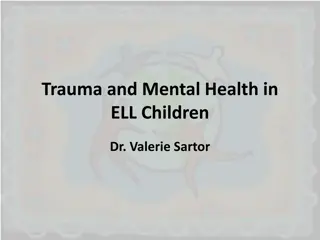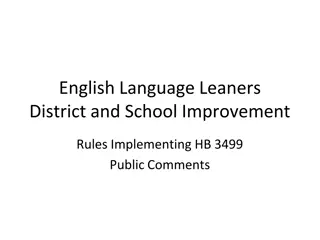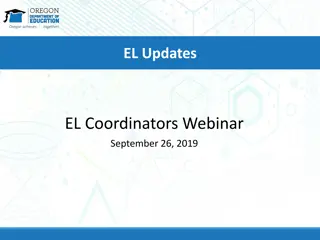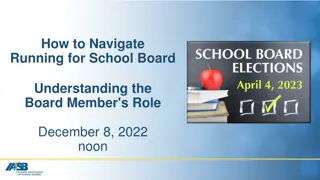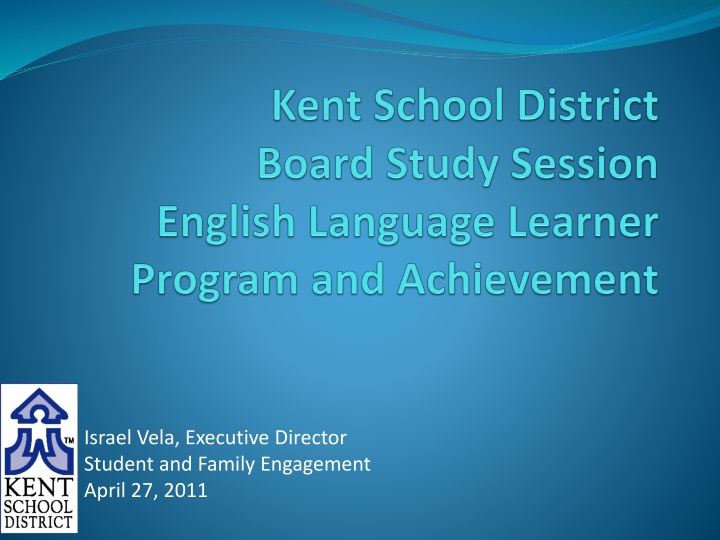
ELL Programs and Demographics in Kent School District
Explore the Transitional Bilingual Instructional Program and ELL Demographics within the Kent School District and Washington State. Learn about funding, student statistics, and program recommendations for English Language Learners.
Download Presentation

Please find below an Image/Link to download the presentation.
The content on the website is provided AS IS for your information and personal use only. It may not be sold, licensed, or shared on other websites without obtaining consent from the author. If you encounter any issues during the download, it is possible that the publisher has removed the file from their server.
You are allowed to download the files provided on this website for personal or commercial use, subject to the condition that they are used lawfully. All files are the property of their respective owners.
The content on the website is provided AS IS for your information and personal use only. It may not be sold, licensed, or shared on other websites without obtaining consent from the author.
E N D
Presentation Transcript
Israel Vela, Executive Director Student and Family Engagement April 27, 2011
Overview of KSD ELL Transitional Bilingual Instructional Program Kent School District and Washington State ELL Comparison English Language Learner Student Information Key Components of Effective Programs for ELLs General Program Recommendations
Transitional Bilingual Instructional Program Provides supplemental funding for English language learners. o Washington Administrative Code (WAC) WAC 392-160-015 o Eligibility based on WLPT (Washington Language Proficiency Test) o Funding used for: Staffing (teachers and para-educators) WLPT (Washington English Language Proficiency Assessment) testing materials Supplementary language development resources Professional development o Per student funding for 2010-2011 school year is $904 KSD o State Bilingual Grant total for 2010-2011 ($3,822,707) o Per Student funding for 2011-2012 school year TBD
ELL Demographics Kent School District - 1/3/11 KSD has approximately 4,342 eligible ELL students (1/3/2011) Washington State - 09/10 Approximately 91,000 ELL students in 2009-10 SY (84,854 funded FTEs) 34% are Spanish, followed by Punjabi & Ukrainian- 8%, Vietnamese 7% , Somali - 6% (Skyward) Of those, 67% were Spanish speakers 197 school districts serve ELL students 40 KSD schools serve ELL students About 46 school districts serve students with 20 or more language groups Over 120 languages KSD is one of 20 districts in Washington KSD is minority majority district. 87% of ELL students are at L2 and L3 level served in content classroom with core content area support from ELL 13% L1 s- served in Newcomer Language Acquisition support 89% in Sheltered Instruction or English as a Second Language Instruction 1. 2.
ELL Enrollment by State Data 18,000 15,433 16,000 Total Number of ELL Students in Washington State 92,405 09/10 14,414 14,000 12,034 Number of ELL Students 12,000 10,000 8,885 8,000 7,071 5,949 6,000 5,118 4,922 4,816 4,042 4,004 4,000 3,081 2,636 15.7% in Grades 9-12 54.9% in Grades K-3 2,000 0 K 1 2 3 4 5 6 7 8 9 10 11 12 GradeLevel
ELL Enrollment by District 800 732 Total Number of ELL Students in Kent School District 4,312 1/3/11 700 651 600 Number of ELL Students 526 486 500 400 340 290 300 262 211 197 195 178 200 164 110 100 0 K 1 2 3 4 5 6 7 8 9 10 11 12 Grade Level
State ELLs Meeting State Targets ELLs meeting state targets for reading, writing and math 100% Level 1-3 90% Percent of Students Meeting Standard Level 4 80% State Target 74% State Target 70% All Students 70% 63% 60% 52% State Target 52% 50% 38% 40% 29% 30% 16% 20% 14% 10% 0% Reading Writing Math
KSD ELLs Meeting State Targets KSD ELLs meeting state targets for reading, writing, and math 80% State Target 74% State Target 70% 70% Percent of Students Meeting Standard 59% 58% 60% State Target 52% 49% 50% 44% Level 1-3 40% Level 4 32% All students 28% 30% 20% 10% 0% Reading Writing Math
Transitional Bilingual Instructional Program, Technical Working Group TBIP charged by Quality Education Council with: Identifying research based programs and services that effectively support the language acquisition and academic needs of ELLs Recommending appropriate outcomes and measures of program effectiveness Determining appropriate state-level funding structure Identifying barriers or capacity issues that hinder implementation of effective programs Identifying other topics deemed to be relevant by the working group
Kent School District Initiatives: Research Based Programs/Resources DST (District Support Team) Tiered Interventions (district ) SIOP Sheltered Instruction Observation Protocol (district) Cultural Competency skills training (district wide) ELD (English Language Development) standards (district) Our Way to English (Elementary ELL program resource Shining Star (Secondary ELL program resource) Services Refugee Transition Center - Transition of refugee students and families Parent and community involvement Interpreters and translations Language Line College and Career Readiness
Measures of Program 09/10 MSP/HSPE met standards WA vs. KSD ELL data % Met Reading standard % Met Math standard % Met Writing standard Met All 3 AMAOs Met Math Standard Met Reading Standard Met AMAO 3 Washington State vs. KSD Grades Grade Span Washington State Total Total No No 21% 17% 32% 3 3-5 No No 31% 28% 6 6-8 No No 15% 12% 10 10 No No 24% 10% 47% Kent School District Total No Yes 20% 19% 32% 3 3-5 Yes Yes 33% 33% 6 6-8 Yes Yes 17% 17% 10 10 NR NR 19% 11% 49%
Challenges Barriers to implementation of effective programs Increased numbers of ELLs Exiting Program delivery ELL endorsed teachers in the district Family involvement/engagement School Improvement Teams Cost of translations and interpreter services (KSD demographics)
Challenges (continued) Barriers to implementation of effective programs Teacher time for collaboration with ELL support staff Focus on academic language for all students Implementation of ELDs (English Language Development focus) ELLs identified for Special Education services Access to core content
Key Components of Effective Program Certified Teachers with ESL/Bilingual Endorsements Teachers need to know strategies to support student s English language development and help ELLs access academic subjects KSD s current teacher data 01/01/2011: 1601 certificated staff 70 ELL endorsed teachers (26 Secondary & 44 Elementary) 4% of total certificated KSD staff are ELL endoresed Additional 40 teachers enrolled in ELL endorsement program through Heritage University Supported and Highly Trained Para-educators 1. 2. 3. 4. Para-educators need to have training and work closely with teachers to ensure student support is aligned to classroom instruction Focus on increasing para-educator professional development: Strategies to support teacher and students 1.
Key Components of Effective Program Professional Development Focus on English language development strategies (SIOP, ELD) Job Embedded ESL/Bilingual support for teachers KSD Professional Development involves: 1. Early Release/Late Start days/Workshop days applying SIOP, TI, DST support from district, Professional Learning Communities (PLC s) 2. ELL teachers team teaching with content area staff - using ELD standards & grade level/department meetings Appropriate Assessments Utilize a range of assessments to accurately identify ELLs English development and academic needs KSD Assessments include: 1. WLPT (Placement) WELPA (Annual) 2. KSD ELL Resource OWE & Shining Star assessments (Elem & Sec) 3. Curriculum Based Measurements (Formative Assessments)
Key Components of Effective Program Additional Instructional Time ELL students need more time outside of traditional school day to become English proficient and learn content material such as math KSD provides: 1. Extended learning/year round school for all Refugee students School based summer programs (July and August) 2. Extended learning in all schools before and/or after school support Family Engagement Families play key role in supporting children s academic performance KSD s Family Engagement: 1. Partnering with Community Groups 2. Staff training in areas of supporting ELLs by increasing knowledge and awareness of students background, gaining strategies & knowledge about value systems 3. Community Involvement & Parent Literacy 4. School Improvement Team Framework
Key Components of Effective Program Smaller Class Size for Interventions Allow student more time with teachers and opportunities to practice their English KSD provides: 1. Intensive small group interventions for ELLs Tiered Interventions and Language Acquisition classes for Newcomers, L1 and L2 s. Supplemental Curriculum Materials ELLs need English language development curriculum Access to on-line supplemental materials that support English language development and improve access to academic content areas KSD provides: 1. On Our Way To English (Elementary) Thematic and Guided Reading 2. Shining Star (Secondary) 3. Language! 4. Odyssey Ware (Secondary students with translation)
Statewide Accountability System Work Group recommends the development of an accountability system to identify districts that are underperforming and those making significant improvement in ELLs performance. The accountability system should include a system of support that provides struggling districts with technical assistance. Work Group recommends assigning OSPI, State Board of Education, and other key stakeholders to develop new accountability system.
State Level Technical Assistance and Monitoring Work Group also recommends an additional two FTE be funded at the state level to: Increase guidance, technical assistance, and professional development opportunities, and Monitor school districts on a three year cycle. Total cost per year - $291,000
Next Steps: To continue with professional development that targets implementation of language acquisition strategies 16% of teachers trained (proportional) Tiered Intervention Model to increase access to core for ELL s Professional Development on ELL resources/content support Continuing support to ELL s who exit out of services Support for struggling secondary students and drop out prevention
Thank you! and Questions?



